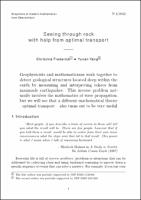| dc.contributor.author | Frederick, Christina | |
| dc.contributor.author | Yang, Yunan | |
| dc.contributor.editor | Kohlrus, Jan | |
| dc.contributor.editor | Randecker, Anja | |
| dc.date.accessioned | 2022-05-06T09:07:06Z | |
| dc.date.available | 2022-05-06T09:07:06Z | |
| dc.date.issued | 2022-05-06 | |
| dc.identifier.uri | http://publications.mfo.de/handle/mfo/3941 | |
| dc.description.abstract | Geophysicists and mathematicians work together to detect geological structures located deep within the earth by measuring and interpreting echoes from manmade earthquakes. This inverse problem naturally involves the mathematics of wave propagation, but we will see that a different mathematical theory – optimal transport – also turns out to be very useful. | en_US |
| dc.language.iso | en | en_US |
| dc.publisher | Mathematisches Forschungsinstitut Oberwolfach | en_US |
| dc.relation.ispartofseries | Snapshots of modern mathematics from Oberwolfach;2022-04 | |
| dc.rights | Attribution-ShareAlike 4.0 International | * |
| dc.rights.uri | http://creativecommons.org/licenses/by-sa/4.0/ | * |
| dc.title | Seeing through rock with help from optimal transport | en_US |
| dc.type | Article | en_US |
| dc.identifier.doi | 10.14760/SNAP-2022-004-EN | |
| local.series.id | SNAP-2022-004-EN | en_US |
| local.subject.snapshot | Numerics and Scientific Computing | en_US |
| dc.identifier.urn | urn:nbn:de:101:1-2022112209225866434487 | |
| dc.identifier.ppn | 1823156010 | |


